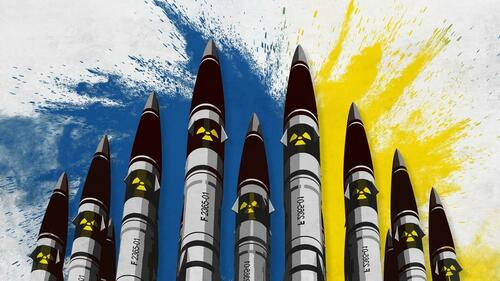
Authored by Tuomas Malinen via GnSEconomics.com,
DEPRCON WARNING
Nuclear Threat (Free)
These are the lines none of us would have ever wanted to write, but we have to. The current situation in and around the war in Ukraine has opened a path, which could lead to a nuclear confrontation.
Ukraine has struck another early-warning (over-the-horizon) radar, this time in Orenburg region, near Orsk, some 1500 km from Ukraine. This radar did not even look at the direction of Ukraine, which makes the strike an act of madness, or something sinister.
These strikes to the Russian early-warning system can serve only two aims:
-
Ukrainian leadership is desperately trying to fully commit NATO to the war in Ukraine, or
-
Strikes are a preparation for nuclear strikes to Russia by the U.S.
Needless to say that the latter is extremely speculative. However, it is one of the two motives that can be established for the strikes. Alas, we have to acknowledge its existence. We have gone through the former in our previous warning.
What is more is that, according to Kremlin, the U.S., the U.K. and France would have deployed ground-based intermediate and short-range missile system to Ukraine. These systems were previously banned by the INF (Intermediate-Range Nuclear Forces) Treaty from which President Trump withdraw the U.S. in February 2019, citing Russian non-compliance and missiles developed by China.
These missile systems can be used to strike deep into Russia. The risk is that, if Ukraine would continue to target the early-warning system of Russia, at some point Kremlin would simply be forced to act, because it would seriously undermine their nuclear deterrence.
Nuclear deterrence operates on three dimensions: time, distance and altitude, in addition to the actual arsenal of nuclear weapons. Time and distance are crucial for the response (retaliation, effectively) and altitude where missiles fly, is crucial for anti-missile and other defense systems to operate. Over-the-horizon radars are crucial for all three dimensions, as early warnings give authorities time, distance and altitude to react and enact defensive measures. If they are taken out, or their ability to detect an approaching intercontinental ballistic missiles (ICBM) seriously hindered, modern nuclear deterrence simply fails. This is the reason, why Kremlin would be forced to react if the early-warning system of Russia would become compromised by a foreign party (Ukraine/NATO). This applies also to the U.S. and all other nuclear powers. Everybody would eventually be forced to react under such a threat.
There are naturally other options than just a nuclear strike for Kremlin, but they all would need to be major, which would enflame the conflict further. If Kremlin would choose to enact a nuclear strike, it would probably use a tactical nuke, which is smaller than a strategical nuke (e.g., an ICBM), and hit a military target, like an airbase.
This is why we (with an extremely heavy heart) issue a warning of a possible nuclear strike in Europe. This warning is effective for the time being.
We don’t present any estimated likelihood for it, at this point at least, as it would be macabre. However we note that, while the likelihood is probably not very high at the moment, if strikes to Russian early-warning system continue, it will grow rapidly.
While still unlikely, we urge you to start to prepare for the unthinkable.
Authored by Tuomas Malinen via GnSEconomics.com,
DEPRCON WARNING
Nuclear Threat (Free)
These are the lines none of us would have ever wanted to write, but we have to. The current situation in and around the war in Ukraine has opened a path, which could lead to a nuclear confrontation.
Ukraine has struck another early-warning (over-the-horizon) radar, this time in Orenburg region, near Orsk, some 1500 km from Ukraine. This radar did not even look at the direction of Ukraine, which makes the strike an act of madness, or something sinister.
These strikes to the Russian early-warning system can serve only two aims:
-
Ukrainian leadership is desperately trying to fully commit NATO to the war in Ukraine, or
-
Strikes are a preparation for nuclear strikes to Russia by the U.S.
Needless to say that the latter is extremely speculative. However, it is one of the two motives that can be established for the strikes. Alas, we have to acknowledge its existence. We have gone through the former in our previous warning.
What is more is that, according to Kremlin, the U.S., the U.K. and France would have deployed ground-based intermediate and short-range missile system to Ukraine. These systems were previously banned by the INF (Intermediate-Range Nuclear Forces) Treaty from which President Trump withdraw the U.S. in February 2019, citing Russian non-compliance and missiles developed by China.
These missile systems can be used to strike deep into Russia. The risk is that, if Ukraine would continue to target the early-warning system of Russia, at some point Kremlin would simply be forced to act, because it would seriously undermine their nuclear deterrence.
Nuclear deterrence operates on three dimensions: time, distance and altitude, in addition to the actual arsenal of nuclear weapons. Time and distance are crucial for the response (retaliation, effectively) and altitude where missiles fly, is crucial for anti-missile and other defense systems to operate. Over-the-horizon radars are crucial for all three dimensions, as early warnings give authorities time, distance and altitude to react and enact defensive measures. If they are taken out, or their ability to detect an approaching intercontinental ballistic missiles (ICBM) seriously hindered, modern nuclear deterrence simply fails. This is the reason, why Kremlin would be forced to react if the early-warning system of Russia would become compromised by a foreign party (Ukraine/NATO). This applies also to the U.S. and all other nuclear powers. Everybody would eventually be forced to react under such a threat.
There are naturally other options than just a nuclear strike for Kremlin, but they all would need to be major, which would enflame the conflict further. If Kremlin would choose to enact a nuclear strike, it would probably use a tactical nuke, which is smaller than a strategical nuke (e.g., an ICBM), and hit a military target, like an airbase.
This is why we (with an extremely heavy heart) issue a warning of a possible nuclear strike in Europe. This warning is effective for the time being.
We don’t present any estimated likelihood for it, at this point at least, as it would be macabre. However we note that, while the likelihood is probably not very high at the moment, if strikes to Russian early-warning system continue, it will grow rapidly.
While still unlikely, we urge you to start to prepare for the unthinkable.
Loading…





